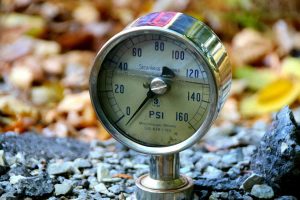 Is your pool filter pressure gauge showing low water pressure? Several possible issues can cause low pressure in your pool system.
Is your pool filter pressure gauge showing low water pressure? Several possible issues can cause low pressure in your pool system.
In this article, we’ll help you troubleshoot some of the most common causes of low water pressure in your pool system.
How a Pool System Works
Let’s start with an extremely oversimplified summary of how your pool system works.
The piping has two sides: a suction side and a return side.
Blockage in the suction side will restrict flow and lead to low pressure. Conversely, a jam in the return side will result in high pressure.
With that in mind, let’s review some of the common causes of low water pressure.
Bad Pressure Gauge
Most pressure gauges are durable and unlikely to go bad, but we’re listing this one first because it can save you some time and money if this turns out to be the problem.
If a bad gauge turns out to be the issue, replace it and test the pressure again.
Low Water Level
If your water level is below the skimmer opening, simply add water to the pool until the water level is roughly halfway up the skimmer door’s opening. The proper water level should restore water pressure.
Clogged Skimmer Basket
If leaves or other debris have built up in the skimmer basket, your pipes may be getting insufficient flow to create pressure.
Be sure to turn off pump first, then remove the skimmer basket and clean out the debris. Cleaning the basket may be enough to restore pressure. Make sure when removing the basket, no debris goes into the suction pipe under the basket.
Clogged Filter
Similarly, debris built up in the filter can restrict flow and reduce pressure. To solve this problem, you’ll want to clean the filter.
Clogged Impeller
Your pool pump impeller is another common location for debris buildup and clogging. Unfortunately, the impeller is often harder to get to than the filter or skimmer basket. Nevertheless, clearing debris from the impeller will improve water pressure in your pool system.
Suction Leak
A cracked o-ring, broken intake fitting or a bad valve can suck air into the system, prevent proper pump-priming, or reduce water flow.
The hardest part about troubleshooting a suction leak is finding it. Once you’ve identified the leak, replace the O-ring or fitting.
Weak or Out-of-Date Pump
If it’s been a while since your last pool pump replacement or upgrade, your pump may simply have too much wear and tear to properly do its job.
If this turns out to be the problem, consider upgrading your pool pump with a Pentair variable speed pool pump. Variable speed pool pumps are quiet, energy-efficient, and durable compared to legacy pumps. Not only that, but they can integrate seamlessly into most pool automation systems.
Finally, these are some of the most common causes of low water pressure in your pool system. If you’ve tried these troubleshooting tips and still haven’t found the problem, give us a call. We’ll be happy to send out a technician to your pool to inspect the problem and make a recommendation.


